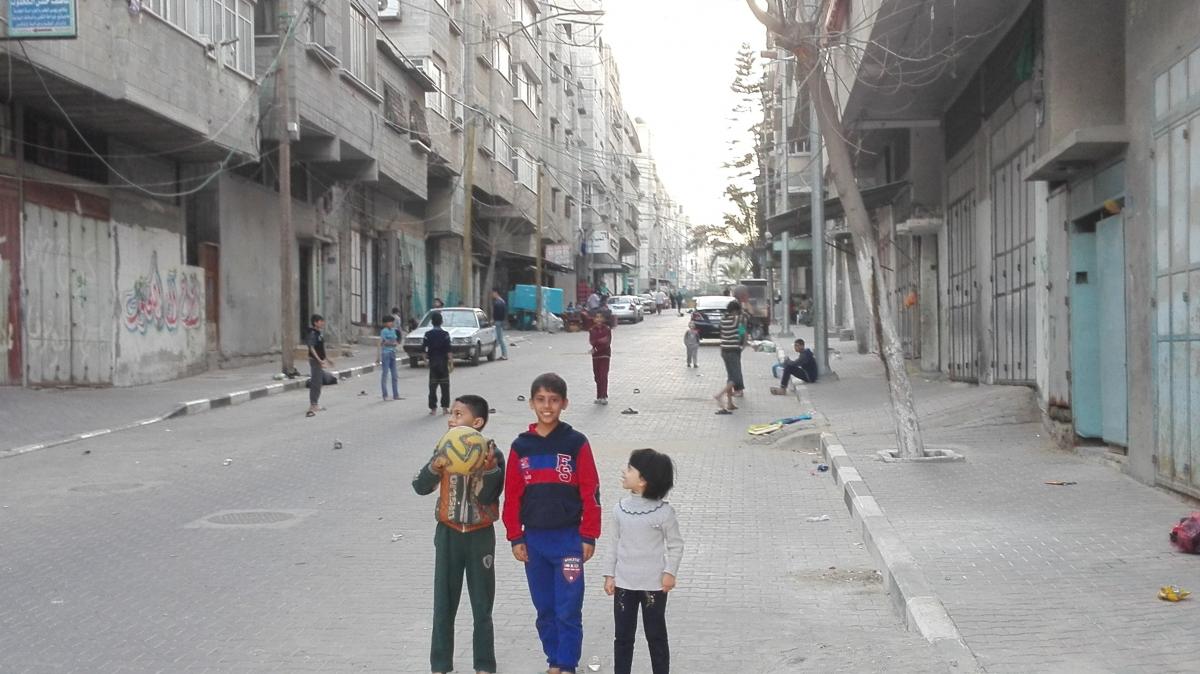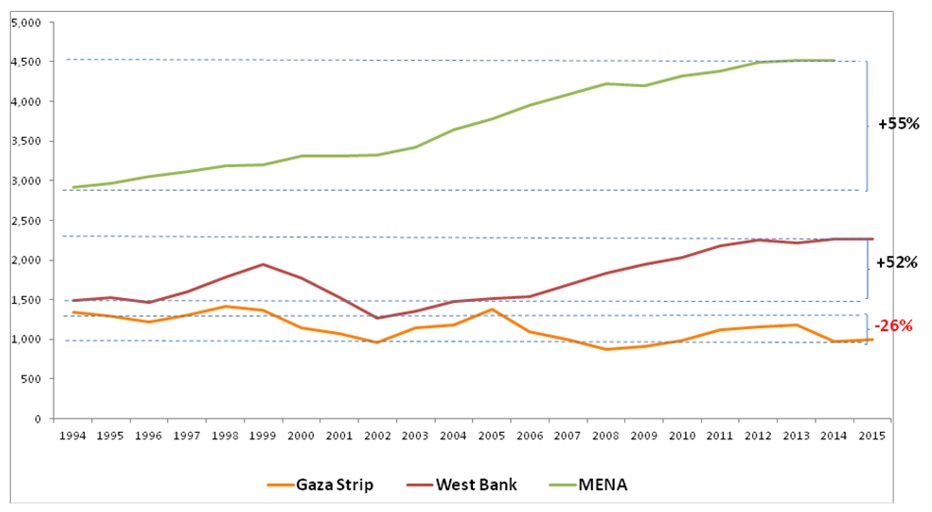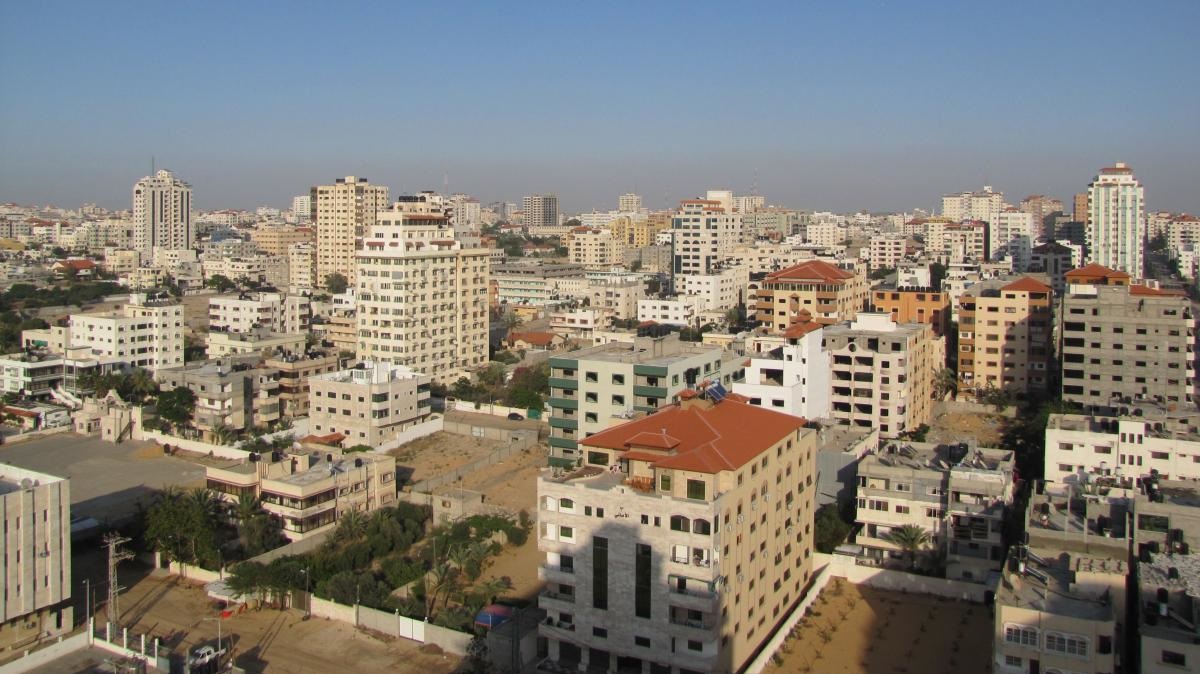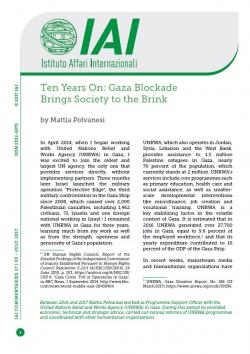Ten Years On: Gaza Blockade Brings Society to the Brink
Ten Years On: Gaza Blockade Brings Society to the Brink
Mattia Polvanesi*
In April 2014, when I began working with United Nations Relief and Works Agency (UNRWA) in Gaza, I was excited to join the oldest and largest UN agency, the only one that provides services directly, without implementing partners. Three months later Israel launched the military operation “Protective Edge”, the third military confrontation in the Gaza Strip since 2008, which caused over 2,000 Palestinian casualties, including 1,462 civilians, 72 Israelis and one foreign national working in Israel.[1] I remained with UNRWA in Gaza for three years, learning much from my work as well as from the strength, openness and generosity of Gaza’s population.
UNRWA, which also operates in Jordan, Syria, Lebanon and the West Bank, provides assistance to 1.3 million Palestine refugees in Gaza, nearly 70 percent of the population, which currently stands at 2 million. UNRWA’s services include core programmes such as primary education, health care and social assistance, as well as smaller-scale developmental interventions like microfinance, job creation and vocational training. UNRWA is a key stabilizing factor in the volatile context of Gaza. It is estimated that in 2016 UNRWA generated over 27,700 jobs in Gaza, equal to 9.6 percent of the employed workforce,[2] and that its yearly expenditure contributed to 16 percent of the GDP of the Gaza Strip.

Gaza City, 2017. With most schools in Gaza operating on double shifts,
education is severely affected. (Photo credit: Mattia Polvanesi)
In recent weeks, mainstream media and humanitarian organizations have placed much emphasis on the 50th anniversary of the June 1967 Arab-Israeli War. However, another bleak and equally important anniversary has passed almost unnoticed: June 2017 also marked 10 years of the Gaza blockade. Following Hamas’ victory in the 2006 Palestinian legislative elections and its violent confrontation with the Fatah-dominated Palestinian Authority (PA) the following year, Israel and Egypt sealed their borders with Gaza, where Hamas took control. Since then, the enclave has been under a land, air and sea blockade preventing the large majority of the population from ever leaving Gaza.
The 2007 blockade intensified earlier restrictions on the movement of goods, services and people that were put in place by Israel since the early 2000s. These constraints – exacerbated by the effects of recurrent military conflicts, the intra-Palestinian political divide and mounting regional turmoil – have generated a plunging socioeconomic spiral, destroying the local economy and job creation capacity. As a result, the previously vibrant, self-sustained and trade-oriented economy in Gaza is today characterized by unemployment and poverty, isolation and an almost complete dependence on international aid.
When asked to brief visiting delegations in Gaza, my starting point was always to stress that as recently as twenty years ago the Strip had a functioning economy. For those who know Gaza from war reports it may seem odd that Gaza was once exporting furniture and textile products, renowned for their quality and low prices. Gaza’s manufacturing sector was hard-hit by the blockade. Its share of GDP fell from 16.2 percent in 1994 to just 4.5 percent in 2015.[3] A short car ride through the centre of Gaza City reveals dozens of furniture workshops, with unsold merchandise stacked up in the streets. Lacking the possibility to export, and faced with Gaza’s low purchasing power, most businesses have been forced to shut down or to severely limit their production.
The impact of the blockade is most clearly measurable in terms of per capita income and purchasing power. GDP per capita in real terms dropped by 24.5 percent compared to 2005, reaching 1,038 dollars in 2016 (nearly three dollars per person per day).[4] Economic contraction has translated into an unemployment rate of over 41 percent in 2016, compared to 18.9 percent in 2000. Youth unemployment soared dramatically to a striking 61.4 percent in 2016, and up to 85.5 percent among female youth.[5]
Figure 1 | Real GDP per capita, US dollars constant prices

Source: Author’s elaboration based on data from PCBS and the World Bank.
The humanitarian needs in Gaza are generated first and foremost by the economic blockade. A source of significant frustration when working in Gaza was witnessing businessmen, who used to employ dozens of workers but have since lost everything, being forced to apply for UNRWA food assistance. The population of Gaza has proven impressively resilient, rebuilding their homes, businesses and livelihoods over and over again. Yet, this resilience cannot continue indefinitely.
The blockade has not only crippled the Gaza economy, but has also irremediably damaged its energy and water infrastructure. In April 2017, Gaza’s only power plant was forced to shut down due to a dispute between the PA and Hamas over fuel tax rates.[6] Since then, people have been experiencing electricity blackouts of 20-22 hours a day. Power shortages are not new in Gaza, which has been chronically deprived of electricity for at least a decade. The energy crisis has taken a heavy toll on water, sanitation and health services, including a halt to hospital emergency departments and a reduction of water supply to once every four days.
In addition to restrictions and recurrent Israeli attacks, Gaza’s power crisis is also a consequence of the disputes between the two main Palestinian factions, and should be read in the context of the PA’s efforts to undermine Hamas’s rule in Gaza. Last April, the West Bank-based PA reduced by at least 30 percent its payments to about 70,000 public employees in the Gaza Strip.[7] If sustained, these salary cuts will have serious repercussions on the already dire socioeconomic environment in Gaza. Recent cuts add to the major financial difficulties affecting Hamas, with many Hamas employees not receiving a full salary since October 2013.
Political and security trends are prohibiting Gaza from fulfilling its potential to stand on its own feet. Thanks to a highly-educated population, a widespread and innovative business mentality and its geographic location, Gaza should be allowed to emerge from its cycle of violence and deprivation and move from being a laboratory of human suffering to one of hope and expectation. Repeated warnings by the UN that Gaza could become uninhabitable by 2020[8] are a stain on the consciousness of regional and international actors, as well as the two rival Palestinian factions, which share a degree of blame for the situation in Gaza.

Gaza City, 2015. With a density of 5,200 people per square km,
Gaza is one of the most crowded places on earth. (Photo credit: Mattia Polvanesi)
In order to begin reversing these trends, Israel should allow Gaza to import much needed raw materials, increase exports and allow people and workers move freely in both directions: in short, Israel should lift the blockade. Not only does the latter amount to a form of collective punishment, but Israeli officials have themselves questioned the blockade’s supposed security benefits.[9] Egypt is also part of the problem, and Egyptian authorities should reopen the Rafah crossing, sealed almost continuously since 2014, and allow for increased development assistance and support for Gaza and its people. Ultimately, Palestinian reconciliation and a consensus government are needed for progress on the diplomatic track as well as for improving the socioeconomic conditions in the Strip.
International donors should ensure that adequate resources are channelled to UNRWA and other humanitarian organizations to guarantee life-saving interventions (health, sanitation, food security) and facilitate job creation in sectors with potential (manufacturing, IT).[10] UNRWA struggles with chronic budget shortfalls every fall. This lack of funds not only threatens the sustainability of critical services (in primis the 267 schools run by the Agency in Gaza) but also undermines efforts towards innovative solutions and longer-term planning.
My three years in Gaza made it clear that, without questioning the valuable and often life-saving assistance provided by UNRWA and other humanitarian organizations, Gaza and its people deserve more than simple food aid or reconstruction grants. What Gaza truly needs is a political horizon, convergent Palestinian policy directions and international pressure to address the lack of freedom and justice. If these conditions are met, Gaza’s population will itself be able to lift the Strip out of its misery and build a better future. It is precisely this sense of hope and purpose that can serve as the best antidote to extremism and violence, something that the architects of the blockade seem to overlook. After ten years of blockade, it is time to radically reassess this policy before a new round of fighting pushes Gaza further over the brink.
* Between 2014 and 2017 Mattia Polvanesi worked as Programme Support Officer with the United Nations Relief and Works Agency (UNRWA) in Gaza. During this period he provided economic, technical and strategic advice, carried out various reforms of UNRWA programmes and coordinated with other humanitarian organizations.
[1] UN Human Rights Council, Report of the Detailed Findings of the Independent Commission of Inquiry Established Pursuant to Human Rights Council Resolution S-21/1 (A/HRC/29/CRP.4), 24 June 2015, p. 153, https://undocs.org/A/HRC/29/CRP.4; “Gaza Crisis: Toll of Operations in Gaza”, in BBC News, 1 September 2014, http://www.bbc.com/news/world-middle-east-28439404.
[2] UNRWA, Gaza Situation Report, No. 186 (23 March 2017), https://www.unrwa.org/node/30396.
[3] Palestinian Central Bureau of Statistics (PCBS), Major National Accounts Variables in Palestine for the Years 2014, 2015 at Constant Prices - Data for the Years 1994-2015 (Value Added in Gaza Strip by Economic Activity for the Years 1994-2015 at Constant Prices), http://www.pcbs.gov.ps/Portals/_Rainbow/Documents/E.NA_Constant.htm; UN Special Coordinator for the Middle East Peace Process (UNSCO), Gaza Ten Years Later, 11 July 2017, p. 15, http://reliefweb.int/node/2117214.
[4] PCBS, Quarterly National Accounts Variables in Palestine for the Years 2015, 2016 at Constant Prices - Data for the Years 2000-2016 (Per Capita Indicators by Region and Quarter for the Years 2011-2016 at Constant Prices), http://www.pcbs.gov.ps/Portals/_Rainbow/Documents/E.QNA_Constant.htm; UNSCO, Gaza Ten Years Later, cit., p. 13.
[5] PCBS, Labour Force Survey Annual Report: 2016, April 2017, p. 26 and 53, http://www.pcbs.gov.ps/Downloads/book2266.pdf.
[6] OCHA, “Gaza Plunges Into Darkness: Severe Deterioration in the Energy Situation”, in The Monthly Humanitarian Bulletin, April 2017, https://www.ochaopt.org/node/9167.
[7] Isra Namey, “Gaza Pay Cuts Deepen Rift between PA and Hamas”, in Al Jazeera, 11 April 2017, http://aje.io/7rtm.
[8] UNSCO, Gaza in 2020: A Liveable Place?, August 2012, https://www.unrwa.org/node/7856.
[9] Shlomi Eldar, “Has Israel Recognized Link between Gaza Blockade, Security Threat?”, in Al-Monitor, 1 March 2017, http://almon.co/2trh.
[10] OCHA, Gaza Crisis: Urgent Funding Appeal, 3 July 2017, https://www.ochaopt.org/node/9214.
-
Dati bibliografici
Roma, IAI, luglio 2017, 5 p. -
In:
-
Numero
17|05




